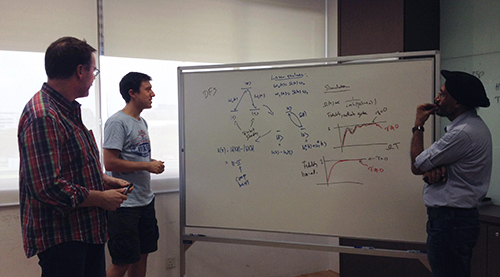Highlights
Theorists see proposal for error-tolerant quantum gates realised
Researchers sometimes have to wait decades for their theoretical ideas to bear fruit: not so the team behind the idea of 'non-adiabatic holonomic quantum computation'. Less than two years after CQT researchers and their collaborators proposed a new way to implement error-tolerant quantum gates, two experimental groups have realised the scheme. One experiment is described in Nature's 25 April issue, the second experiment is described in a paper in press at Physical Review Letters.

Two experiments by different teams have demonstrated the 'non-adiabatic holonomic quantum gates' recently proposed by CQT theorists and their collaborators. Pictured from left to right are Erik Sjoqvist, Markus Johansson and Kuldip Singh.
"We showed how to do things in a much simpler way than what was known before. This simplification apparently opened the way for experiments," says Erik Sjoqvist, first author on the paper and a CQT Visiting Research Professor from Uppsala University, Sweden.
Quantum gates are the building blocks of quantum computation, equivalent to the logic operations such as NOT and AND which perform calculations in conventional electronics. Given a small set of quantum gates, any computation becomes possible — opening the way to achieving the fast calculations promised by quantum algorithms.
In 1999, researchers suggested that gates could be implemented by manipulating a property of quantum bits (qubits) known as their 'non-Abelian geometric phase' or holonomic phase. This phase should be less affected by environmental noise than a state's energy level, the target of other gate approaches. Since noise-induced error is a big problem for quantum computation, this made holonomic quantum computing attractive.
But schemes for holonomic gates in various physical systems — including trapped ions, superconducting circuits and quantum dots — have remained unrealised. The reason is that the schemes required 'adiabatic' implementation: the quantum states had to be influenced slowly, without injecting any energy into the system. With noise degrading the quantum state, time to do things slowly is an unaffordable luxury.
Speed is what the CQT team and their collaborators offered with their scheme for non-adiabatic gates. They showed how to implement such non-adiabatic gates and calculated that these gates should be as reliable as the adiabatic kind. The proposal from Erik and his colleagues was posted to the arXiv preprint server in July 2011 and later appeared in New Journal of Physics.
Their proposed gate scheme was general, in that it could be applied to any quantum system having three energy levels. This led to the two recent experiments being performed not only by different teams on opposite sides of the world but also in entirely different systems.
Researchers at ETH Zurich in Switzerland implemented the proposed one-qubit gates in a superconducting system (a transmon). This is the work published in Nature. Researchers from Tsinghua University and Tsinghua National Laboratory of Information Science and Technology in Beijing, China, implemented the proposed one- and two-qubit gates using nuclear magnetic resonance (NMR) techniques. This work is described in the paper accepted at Physical Review Letters.
The collaboration behind the proposal for non-adiabatic holonomic quantum gates was also international. Erik's coauthors are Dianmin Tong from Shandong University, Jinan, China; Mauritz Andersson from the Royal Institute of Technology in Sweden and CQTians Markus Johansson, Bjorn Hessmo and Kuldip Singh.
Find the theoretical proposal in "Non-adiabatic holonomic quantum computation" New J. Phys. 14 103035 (2012); arXiv:1107.5127.
The experiments are described in "Experimental realization of non-Abelian non-adiabatic geometric gates" Nature 496, 482 (2013); arXiv: 1304.5186 and "Experimental Realization of Nonadiabatic Holonomic Quantum Computation" Phys. Rev. Lett. (in press); arxiv:1302.0384.






